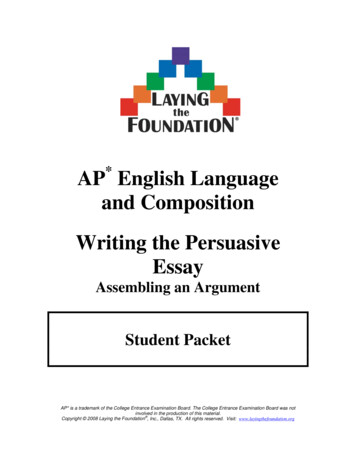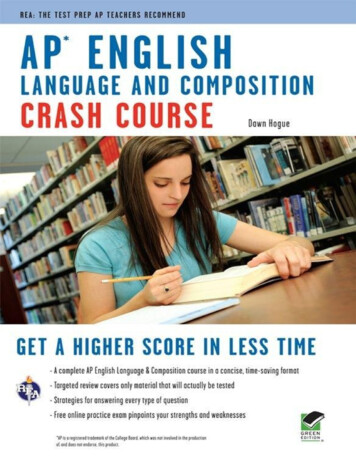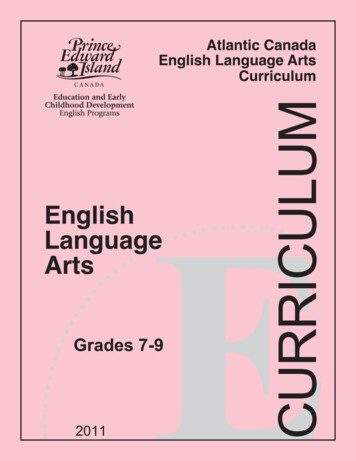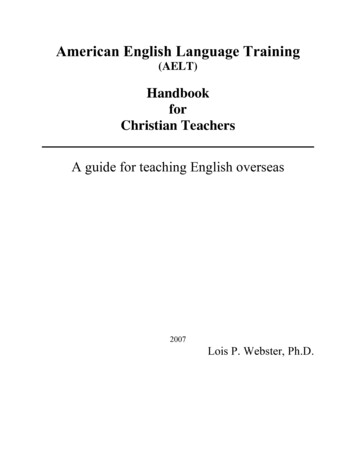
Transcription
*AP English Languageand CompositionWriting the PersuasiveEssayAssembling an ArgumentStudent PacketAP* is a trademark of the College Entrance Examination Board. The College Entrance Examination Board was notinvolved in the production of this material. Copyright 2008 Laying the Foundation , Inc., Dallas, TX. All rights reserved. Visit: www.layingthefoundation.org
Writing the Persuasive Essay:Assembling an ArgumentStudent ActivityIntroductionOne third of the AP* English Language and Composition Exam will require you to writea persuasive essay. The good news is that this is your opportunity to use all of the skillsand clever tactics that you have learned from reading established writers all year long.Even more good news is that steadily over the past few years, the writers of the examhave tried to make the persuasive prompt more and more “high school friendly;” in otherwords, you will get a topic that you, a young adult in high school, can answer.The Five Canons of RhetoricOften the hardest part of writing a persuasive essay is beginning. The first of the fivecanons of rhetoric is called inventio, or invention. This is the point where youbrainstorm, pre-write, use graphic organizers, etc. to plot out ideas for your essay. Onceyou know the evidence you are going to use, the essay is much easier to write because thehardest part is done—thinking of what to write and how to convince your audience.The second canon is dispositio, or arrangement. In the Classical (with a capital ‘C’)Ages, rhetoric was performed before an audience that anticipated a particular order to thespeeches. Speakers, or rhetors, studied a set pattern, wrote and practiced their speeches,and performed them in public in something approaching the way we think of trainedactors performing today. Arguably, this should be the easiest of the five canons becauseit is a set pattern, yet structuring the essay trips up more than its fair share of students.Third is elocutio, or speaking. Again, Classically speaking, this refers to how the rhetorperforms the speech, but for modern purposes we call this style. Speeches were to begrammatically correct, clear, appropriate for their subject and audience, and“ornamented.” No doubt you recognize having been instructed by your teacher to do thefirst three. Ornamentation refers to the unusual uses of language that draw in and holdyour audience, so this is your chance to use figurative language, avoid cliché, and be thenew Twain or Hemingway or King.The fourth canon is memoria: memory. Ancient rhetors memorized their speeches withthe help of various methods of arrangement and study, and while this might seem like acanon that you, the modern essay-writing student, could ignore, you would do so at yourperil. Memoria also involves the wide body of examples and knowledge of your subjectthat establish your credibility as an author. Every anecdote, every fact, every allusionyou employ comes from memory, or that which you have learned. This is where yourhours watching the news and reading snooty, east coast literary journals named after deadwhite guys pay off. (Or you could simply read the local newspaper and stay current.)AP* is a trademark of the College Entrance Examination Board. The College Entrance Examination Board was notinvolved in the production of this material. Copyright 2009 Laying the Foundation , Inc., Dallas, TX. All rights reserved. Visit: www.layingthefoundation.org1
Student Activity—Assembling an ArgumentThe final canon is pronuntiatio, or delivery. As new means of delivering a speech havedeveloped, this canon has evolved right along with them. Essentially, the delivery dealswith the method of presenting the material; fortunately, the method has already beenchosen in advance. You will not perform a monologue, make a film, compose a poem, orinterpret your position through dance; you will write an essay.Activity One: Understanding the PromptRead the following prompt and answer the questions that follow:A recent survey of the top 500 colleges found that fully 10% of admissions officersconfessed to looking at social-networking sites to evaluate prospective students. Ofthose, more than a third said that what they read online negatively impacted their decisionto admit; in contrast, only a quarter said their view changed for the better. While theoverwhelming majority of the colleges have no official policy regarding the reading ofsocial-networking sites, they admit that there is no clear boundary.The dangers are plenty, and they are not limited to disqualification for college admission.Attorneys regularly use information gleaned on the Internet to prosecute criminal andcivil suits against minors. In 2007, a vindictive mom concocted an online hoax thatdrove her daughter’s “ex-best friend,” a 13-year-old girl, to commit suicide. With somany potential threats online, the question becomes, then, should minors be allowed topost personal internet content about themselves or their friends?Consider both sides of the issue. Then, using appropriate evidence, write an essay inwhich you evaluate the pros and cons of allowing minors to create personal web pages,and indicate why you find one position more persuasive than the other.1. What is the subject of the paragraph and prompt?2. What are the tasks of the prompt?3. Where will the evidence for support come from? Copyright 2009 Laying the Foundation , Inc., Dallas, TX. All rights reserved. Visit: www.layingthefoundation.org2
Student Activity—Assembling an ArgumentActivity Two: Brainstorming IdeasFill out the chart to help you evaluate both sides of the argument and to develop ideas forsupporting those points.Reasons to allow minors tocreate personal web pagesEvidence to support yourclaimType of AppealMinors’ primarily use for webpages to discover their world andthemselves.Fact/Statistic: According towatchdog groups the averageblogger is a teenage girl whocommunicates with 5-10 friends.logical and ethicalReasons not to allow minors Evidence to support yourto create personal pagesclaimType of AppealPeer pressure often makes peoplepost things they later regret.logical and emotionalAnecdotal: Current mediacampaign to keep teens fromposting revealing personalphotos. Copyright 2009 Laying the Foundation , Inc., Dallas, TX. All rights reserved. Visit: www.layingthefoundation.org3
Student Activity—Assembling an ArgumentActivity Three: Writing the Thesis StatementWhat is the topic?Make a general statement about it.Now write a thesis statement in which you take a position you will defend withappropriate evidence. Look at the pre-writing you have done. What is your position on the topic? Remember that the task demands that you examine and evaluate both sides of theissue.(I believe that) Minors should(write your position for or against)because(give a GENERAL statement of your reasoning).FYI: First Person Personal PronounsThe jury is out on using “I” in an essay. Many teachers discourage their students fromusing it, even going so far as marking down papers that contain “I.” After all, even whenyou write a rhetorical analysis in third person about another author’s work, “I believe” or“I think” is implied because it’s what you wrote when you thought about the topic; it istherefore redundant (some teachers claim) to use the first person.On the other hand, first person is a legitimate writing tool. In many cases it personalizesan argument, making that which is cold and clinical warmer and more palatable.Furthermore, a great many of the texts used by the exam itself are first personexplorations of a topic. Ultimately, you will have to decide whether or not to write infirst person based on your reading of the prompt and your evaluation of the topic’sseriousness, but take heart in this: the reader of your AP* exam has been instructed toreward you for your argument, not penalize you for your style choice. Copyright 2009 Laying the Foundation , Inc., Dallas, TX. All rights reserved. Visit: www.layingthefoundation.org4
Student Activity—Assembling an ArgumentActivity Four: Writing the IntroductionThe introduction to the paper is your opportunity to capture the reader’s attention, to givesome general information about the subject, and to provide the “road map” for youressay—your thesis statement.Here are some strategies that you might use to begin your introductory paragraph. Youcan begin with: a short anecdote that deals with the “big idea” of your argument a concession an interesting or controversial fact or statistic a question or several questions that will be answered in your argument relevant background material an analogy or image that you can sustain (revisit) throughout the argument a definition of a term or idea that is central to your argument1. What kind of introduction strategy (from the choices above) might you use tobegin this essay?2. Choose one and write a “trial” introduction. You may want to revise or changethis once you have written the essay. You should end the introduction with yourthesis statement from Activity Three. Copyright 2009 Laying the Foundation , Inc., Dallas, TX. All rights reserved. Visit: www.layingthefoundation.org5
Student Activity—Assembling an ArgumentActivity Five: Writing the Persuasive EssayBelow is a sample persuasive essay based on the prompt in the box. Read over it andthink about how the essay is organized and what kinds of strategies are used to defend theclaim, which is made in the thesis statement.Recently, several states have enacted legislation to limit the use of cellular phones inpublic places. Their reasoning was simple: cell phones are dangerous. Write an essay inwhich you defend, challenge, or qualify the lawmakers’ assertion.Introduction: As states initiate more and more strict legislation of cell phone use,the greater public seems to find ever more foolish things to do with their devices. Fromtext messaging while driving to blatant disregard of safety warnings, one conclusionseems inescapable: cell phones are, indeed, dangerous tools.Body paragraph 1:Topic sentence (which may include a concession/counterargument): Only “other people” do idiotic things, not rational people like us.Evidence 1 to support claim: Only the most foolhardy and irresponsible members ofsociety would take their eyes off the road and their hands off the wheel while driving toread and text on their mobile phones. Explanation of how evidence 1 supports claim:After all, when operating a roughly one ton machine at speeds regularly in excess of20mph, “we” would never allow ourselves to flaunt the laws of common sense.Transition to next idea: Unfortunately, we have all been guilty at some point ofignoring the fundamentals of common sense because we do not believe bad things canhappen to us. Evidence 2 to support claim (This should be the same type ofevidence): Something as simple as reaching for an open soft drink container canperilously divert our attention from the road; therefore, an engaging conversation about alegal brief, a homework assignment, even a particularly juicy piece of gossip can be justas deadly. Explanation of how evidence 2 supports claim: We can safely assume thatwith the exception of getting directions to a particular destination, few if anyconversations are about the road conditions around us. Cell phones are a dangerousdistraction.For your use, not for the essay:Note the type of evidence you use here: Anecdotal evidence about talking and driving. Copyright 2009 Laying the Foundation , Inc., Dallas, TX. All rights reserved. Visit: www.layingthefoundation.org6
Student Activity—Assembling an ArgumentBody paragraph 2: Transition to the next paragraph/ topic sentence (which mayinclude a concession/ counterargument): Putting aside abuses of common sense, thequestion of public health must be addressed as well; cell phone users risk exposure topotentially harmful doses of microwave radiation. Evidence 3 to support claim: Thefederal government does issue maximum allowances for cellular phones’ microwaveemissions, and current models stay well within those regulations. Still, cell phonemanufacturers and communications experts alike recommend using wired ear-buds ratherthan holding the devices against the head for prolonged periods of time because—let’sface it—radiation is radiation. Explanation of how evidence 3 supports claim: If youhold a minimally shielded microwave emitting device against your head (in other words,if you use a cell phone like a normal person) you risk your future health. Transition tonext idea: The most popular alternative to speaking directly into the phone is not muchbetter. Evidence 4 to support claim: Even the Bluetooth capable headsets do, bydesign, transmit and receive a signal. Explanation of how evidence 4 supports claim:If we grant that a cellular device’s microwave transmission may be potentially harmful tothe outside of our heads, then it does not follow that we should instead put it inside ourears.For your use, not for the essay:Note the type of evidence you use here: facts about the dangers of microwave radiation.Conclusion: Whether it is because of handheld use while driving or ignorance of thedangers of unshielded radiation, the federal government is absolutely in the right toregulate cell phone use in public. It is a fact that cell phones have saturated society to thepoint where even elementary school children regularly use them—they are simply tooentrenched in daily life to ban outright; however, efforts must be enacted to control theirpublic use to protect society against the reckless, and to protect society’s health against apoorly recognized danger. Copyright 2009 Laying the Foundation , Inc., Dallas, TX. All rights reserved. Visit: www.layingthefoundation.org7
Student Activity—Assembling an ArgumentTemplate for Writing the Persuasive EssayIntroduction: (Use the trial introduction you wrote that includes your thesis.)Body paragraph 1: (Should include a topic sentence)Topic sentence (which may include a concession/counterargument):Evidence 1 to support claim:Explanation of how evidence 1 supports claim:Transition to next idea:Evidence 2 to support claim (This should be the same type of evidence): Copyright 2009 Laying the Foundation , Inc., Dallas, TX. All rights reserved. Visit: www.layingthefoundation.org8
Student Activity—Assembling an ArgumentExplanation of how evidence 2 supports claim:For your use, not for the essay:Note the type of evidence you use here:Body paragraph 2: (When you change the type of evidence, you begin a new paragraph.)Transition to next paragraph/ topic sentence (which may include a concession/counterargument):Evidence 3 to support claim:Explanation of how evidence 3 supports claim:Transition to next idea:Evidence 4 to support claim (This should be the same type of evidence): Copyright 2009 Laying the Foundation , Inc., Dallas, TX. All rights reserved. Visit: www.layingthefoundation.org9
Student Activity—Assembling an ArgumentExplanation of how evidence 4 supports claim:For your use, not for the essay:Note the type of evidence you use here:Conclusion: Use one of the strategies below.Conclusion strategies: Ask a pertinent question Present a final vivid and memorable image Provide an accurate and useful analogy Dismiss an opposing idea Predict future consequences Call for further action Return to a scene or anecdote from the introductionFor your use, not for the essay:The conclusion usesstrategy to provide a strongending for the essay. Copyright 2009 Laying the Foundation , Inc., Dallas, TX. All rights reserved. Visit: www.layingthefoundation.org10
Student Activity—Assembling an ArgumentActivity Six: Evaluating Your ArgumentThese are the same questions you have answered when evaluating other pieces ofpersuasive texts. One of your goals should be to make your persuasive writing aspolished and professional as possible. So, treating your own persuasive writing as a pieceof published work, you will evaluate your own argument by answering the followingquestions. Use the text from your essay to complete the “textual evidence” column.Questions to evaluate theargumentWhat is the writer’s/speaker’spurpose?Textual EvidenceAnswerWhat does he/she hope toaccomplish?Who is the audience?What assumptions about theaudience does the writer/speakermake?What authority does thewriter/speaker have that makeshim/her credible?What claims does thewriter/speaker make?What issues are addressed orignored? Copyright 2009 Laying the Foundation , Inc., Dallas, TX. All rights reserved. Visit: www.layingthefoundation.org11
Assembling an Argument Student Activity Introduction One third of the AP* English Language and Composition Exam will require you to write a persuasive essay. The good news is that this is your opportunity to use all of the skills and clever tactics that you hav










